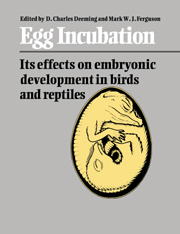Book contents
- Frontmatter
- Contents
- Preface
- Contributors
- 1 Maternal diet, maternal proteins and egg quality
- 2 Comparative composition and utilisation of yolk lipid by embryonic birds and reptiles
- 3 Oviductal proteins and their influence on embryonic development in birds and reptiles
- 4 Fluxes during embryogenesis
- 5 Eggshell structure and formation in eggs of oviparous reptiles
- 6 Shell structure and formation in avian eggs
- 7 Physical characteristics of reptilian eggs and a comparison with avian eggs
- 8 Egg-shape in birds
- 9 The thermal energetics of incubated bird eggs
- 10 Physiological effects of incubation temperature on embryonic development in reptiles and birds
- 11 Cold torpor, diapause, delayed hatching and aestivation in reptiles and birds
- 12 Physical factors affecting the water exchange of buried reptile eggs
- 13 Physiological and ecological importance of water to embryos of oviparous reptiles
- 14 Roles of water in avian eggs
- 15 Water economy and solute regulation of reptilian and avian embryos
- 16 The avian eggshell as a mediating barrier: respiratory gas fluxes and pressures during development
- 17 Gas exchange across reptilian eggshells
- 18 Metabolism and energetics of reptilian and avian embryos
- 19 Reasons for the dichotomy in egg turning in birds and reptiles
- 20 A comparison of reptilian eggs with those of megapode birds
- 21 Why birds lay eggs
- 22 Influences of incubation requirements on the evolution of viviparity
- 23 Overview of early stages of avian and reptilian development
- 24 Ions and ion regulating mechanisms in the developing fowl embryo
- 25 Electrochemical processes during embryonic development
- 26 Methods for shell-less and semi-shell-less culture of avian and reptilian embryos
- 27 Experimental studies on cultured, shell-less fowl embryos: calcium transport, skeletal development, and cardio-vascular functions
- Index
20 - A comparison of reptilian eggs with those of megapode birds
Published online by Cambridge University Press: 16 November 2009
- Frontmatter
- Contents
- Preface
- Contributors
- 1 Maternal diet, maternal proteins and egg quality
- 2 Comparative composition and utilisation of yolk lipid by embryonic birds and reptiles
- 3 Oviductal proteins and their influence on embryonic development in birds and reptiles
- 4 Fluxes during embryogenesis
- 5 Eggshell structure and formation in eggs of oviparous reptiles
- 6 Shell structure and formation in avian eggs
- 7 Physical characteristics of reptilian eggs and a comparison with avian eggs
- 8 Egg-shape in birds
- 9 The thermal energetics of incubated bird eggs
- 10 Physiological effects of incubation temperature on embryonic development in reptiles and birds
- 11 Cold torpor, diapause, delayed hatching and aestivation in reptiles and birds
- 12 Physical factors affecting the water exchange of buried reptile eggs
- 13 Physiological and ecological importance of water to embryos of oviparous reptiles
- 14 Roles of water in avian eggs
- 15 Water economy and solute regulation of reptilian and avian embryos
- 16 The avian eggshell as a mediating barrier: respiratory gas fluxes and pressures during development
- 17 Gas exchange across reptilian eggshells
- 18 Metabolism and energetics of reptilian and avian embryos
- 19 Reasons for the dichotomy in egg turning in birds and reptiles
- 20 A comparison of reptilian eggs with those of megapode birds
- 21 Why birds lay eggs
- 22 Influences of incubation requirements on the evolution of viviparity
- 23 Overview of early stages of avian and reptilian development
- 24 Ions and ion regulating mechanisms in the developing fowl embryo
- 25 Electrochemical processes during embryonic development
- 26 Methods for shell-less and semi-shell-less culture of avian and reptilian embryos
- 27 Experimental studies on cultured, shell-less fowl embryos: calcium transport, skeletal development, and cardio-vascular functions
- Index
Summary
Introduction
Most reptiles that lay eggs bury them in soil or, in the case of certain crocodilians, in mounds of decaying vegetation. The gaseous environment that these buried eggs experience can be very different from those of the atmosphere (Seymour & Ackerman, 1980). By contrast, avian eggs are usually exposed to more or less atmospheric gaseous conditions (Walsberg, 1980). An exception is the Megapodiidae, a family of galliform birds confined to the Australasian region, which bury their eggs in soil or mounds of decaying vegetation in a manner similar to that of reptiles (Firth, 1956a). In this chapter we discuss the similarities and differences in incubation biology of buried eggs of reptiles and megapodes and compare their gaseous and thermal environment to that of open nesting birds. All avian eggs have hard calcareous shells, so our comparisons tend to focus on rigid-shelled reptilian eggs. Most of the information for megapode eggs comes from just two species, the malleefowl (Leipoa ocellata) and Australian brush turkey (Alectura lathami). Similarly, information on rigid-shelled reptilian eggs relies heavily on the crocodilians Crocodylus johnsoni, Crocodylus porosus, and Alligator mississippiensis.
Physical characteristics of eggs
Egg and clutch size
Eggs of megapodes range in mass from 80 g in the Polynesian scrubfowl Megapodius pritchardii to 220 g in the maleo bird Macrocephalon maleo (Schönwetter, 1960-1983). Reptiles that lay rigid-shelled eggs are restricted to two subfamilies of geckos and possibly the Dibamidae amongst the Squamata, some chelonians and all crocodilians (Packard & Packard, 1988).
- Type
- Chapter
- Information
- Egg IncubationIts Effects on Embryonic Development in Birds and Reptiles, pp. 325 - 344Publisher: Cambridge University PressPrint publication year: 1991
- 38
- Cited by



